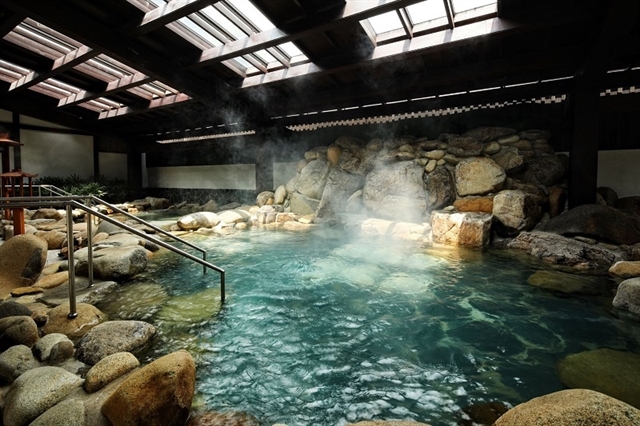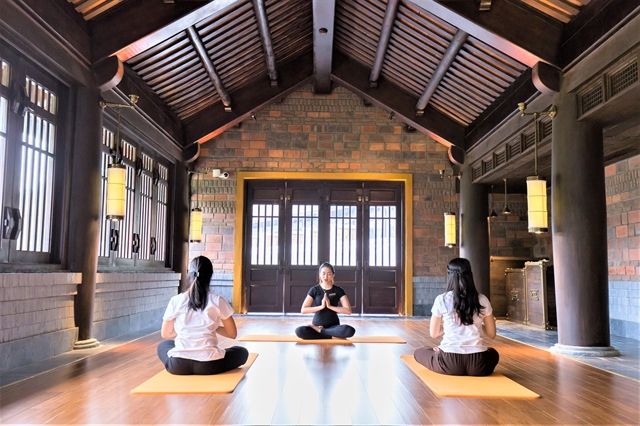 Features
Features

Quảng Ninh, a travel hub in northern Việt Nam, is trying to bring more visitors to the province through wellness tourism.

|
| Quang Hanh hot springs offers one of the mineral water mines with the highest content of hot mineralized Bromine in the world. — Photo courtesy of Sungroup |
Nguyễn Minh Hương
Quảng Ninh, a travel hub in northern Việt Nam, is trying to bring more visitors to the province through wellness tourism.
Since last month, landmarks in the province have become more and more bustling, with tourists inside and outside the province beginning to travel after long periods of staying home due to the lengthy COVID-19 pandemic.
The number of visitors at holiday destinations in the province has risen considerably at the weekends, with Legacy Yên Tử and Yoko Onsen Quang Hanh both reaching over 80 per cent capacity.
The pandemic has meant there has been a shift towards safety, and only establishments with safety certificates are allowed to operate, to protect tourists in the ‘new normal’.
While boutique hotel Legacy Yên Tử has recorded a large number of visitors, more than 1,000 over the weekend, natural spa resort Yoko Onsen Quang Hanh has been almost fully booked since it resumed operations in October.
The hot springs of Quang Hanh have been shown having natural mineral water with among the highest content of hot mineralized bromine in the world.
Sun Group's Yoko Onsen Quang Hanh has long been an attraction to tourists, especially those that long for wellness and relaxation.
“When we resumed in October most of the visitors were from Quảng Ninh. At the weekends, the number of visitors reached the same level as the opening period of 2020,” Vũ Thanh Thủy, manager of Yoko Onsen Quang Hanh, told Việt Nam News.
“Last month, the number of visitors from Hà Nội, Hải Phòng and Bắc Ninh began to increase. But by end of November, the number of non-Quảng Ninh tourists was double that of provincial tourists."
As the hot mineral water is known to help eliminate toxins, as well as relieve muscle and joint pain, it is considered a refresher for the mind and can reduce stress.
Thuỷ estimates that they will have more visitors until the end of the coming Lunar New Year, as travel returns to normal, and the rate of people who have fully vaccinated has increased, and 5K anti-virus regulations continue to be seriously applied.
Phùng Hữu Hoàng, a representative of Saigon Tourist, said that the company was deploying products in the province to catch the wellness tourism trend.

|
| Legacy Yên Tử gives its guests free morning yoga class while staying at the resort in Quảng Ninh Province. — Photo courtesy of MGallery |
Other than Yoko Onsen Quang Hanh, places that offer so-called detox tourism include Legacy Yên Tử and Premier Village Halong Bay Resort.
Hoàng said they would serve high-income tourists who want to improve their health and seek high-class services in the province.
Phạm Ngọc Thuỷ, director of the Quảng Ninh Department of Tourism, said: “The future of Quảng Ninh tourism will be resort tourism and wellness tourism and will be associated with the sea and islands — an advantage that is probably not available in other provinces.”
Together with wellness, other tourist attractions include Hạ Long Bay, and Quảng Ninh Museum, which have also recently received more local and foreign tourists.
In the last weekend of November, the province received more than 6,000 visitors. Since the easing of social distancing from the end of September, 70,000 tourists arrived in the province.
Leaders of the province told local media that they expected to welcome more than 2 million visitors in the last quarter of the year, with incentive programmes from tourism and hospitality businesses such as free tickets to Hạ Long Bay, Yên Tử cable car discounts, discounts on rooms and services, and more.
Together with the promotions, the province has also developed programmes and packages of safe tourism products to fit the new normal.
These moves focus on building care-free tourism models in areas relatively isolated from the mainland, with long stays in Tuần Châu Island and other islands in the districts of Cô Tô, Vân Đồn and Hải Hà and Móng Cái City, as well as in the highland communes of Bình Liêu District.

|
| White reeds on the hills are attraction of Bình Liêu mountain area in Quảng Ninh.— Photo courtesy of dulichquangninh |
By the end of 2021, Quảng Ninh plans to organize about 50 events and activities to stimulate tourism demand,” Ngọc Thuỷ said.
At the same time, his department has developed a plan to welcome international guests and continued to ensure pandemic prevention and control for tourism businesses in the region.
The province has effectively implemented a government resolution on "Safe adaptation, flexibility, effective control of the COVID-19 pandemic" in tourism, which ensures the safe arrival of guests and strict pandemic prevention measures.
The province is ready to restart tourism under the new conditions, while contributing to removing difficulties for tourism services and businesses.
According to a Quảng Ninh tourism official, in order to safely welcome guests and prevent the situation getting out of control, epidemic prevention work at the local port is being carried out in accordance with a closed passenger pick-up and drop-off process.
All visitors are required to scan QR codes before disembarking. Staff at the port and fleet are periodically tested every two days.
Ngọc Thuỷ said that the province also participated in an online tourism fair in HCM City, with a virtual booth themed: "Quảng Ninh - Hạ Long Bay and more".
Together with luxury resorts, beaches and islands, the northern province is also showcasing the beauty of its mountainous area with "Bình Liêu Culture Week", as well as its golden rice fields and flower terraces.
In the first nine months of this year, Quảng Ninh received over 2.58 million visitors and gained total revenue of VNĐ5 trillion (US$217.3 million).
The province plans to welcome 2 million more tourists and earn up to VNĐ4.5 trillion in the last quarter. —VNS




